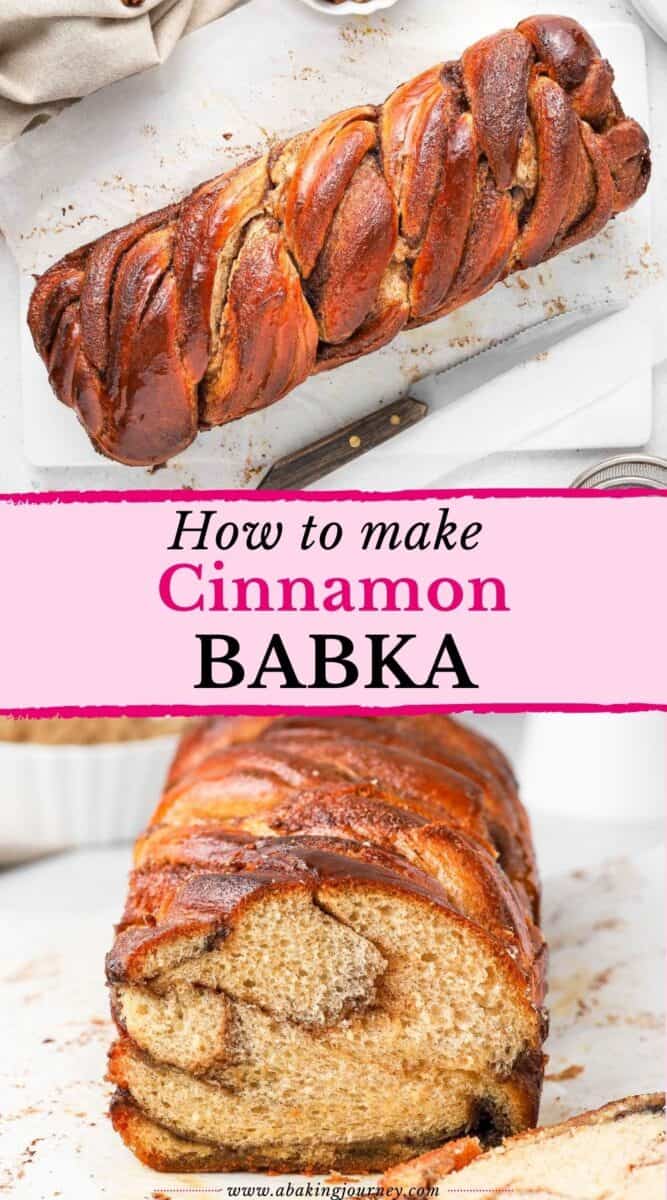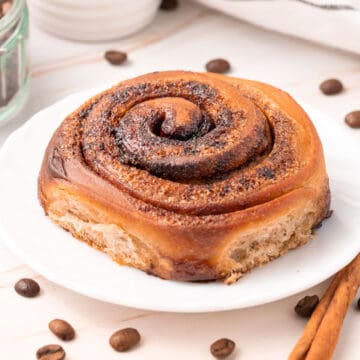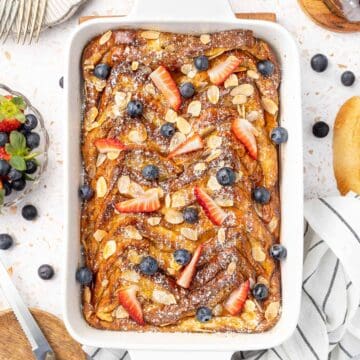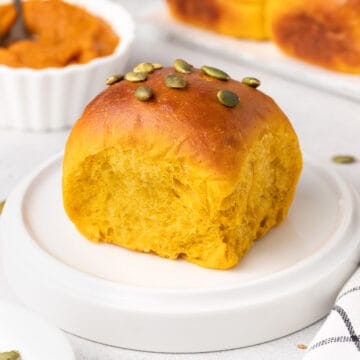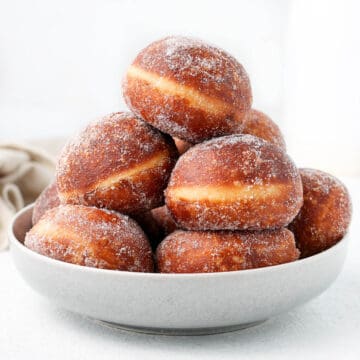This Cinnamon Babka is an incredibly indulgent enriched sweet bread made with swirls of cinnamon. This cinnamon twist bread is soft, fluffy, buttery and completely irresistible! Toast a slice for breakfast, serve it as dessert or enjoy it with your afternoon tea.
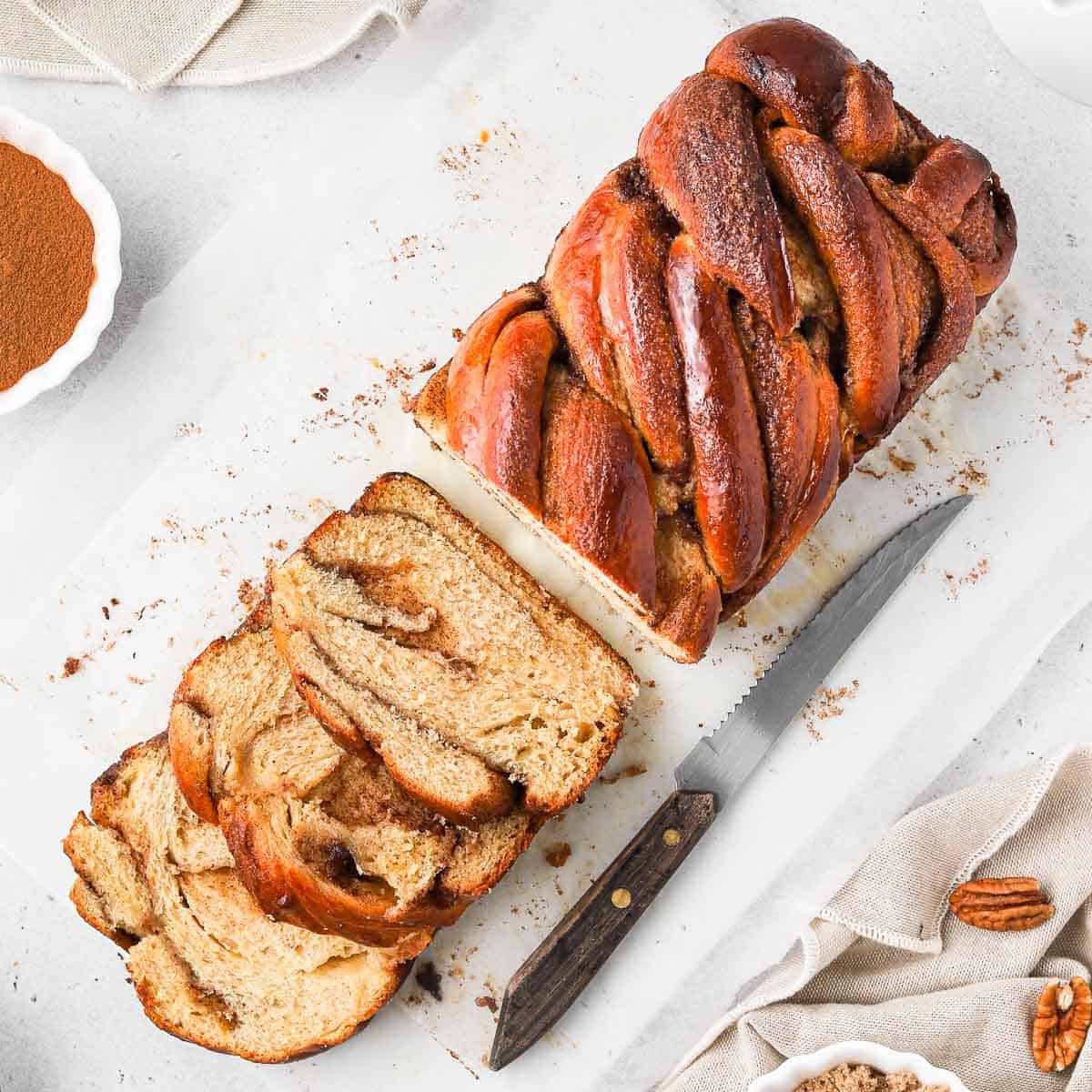
Jump to:
Why we love this recipe
When I say that this Cinnamon Babka loaf bread is irresistible, I really mean it. You will want to keep going for more. And more. And more! It is a fun twist on a Cinnamon Roll Bread too.
The brioche-style yeasted dough is delicious treat that is tender, buttery and only made better by the swirls of the gooey cinnamon and brown sugar filling. It will make your whole house smell incredible, just like a batch of freshly baked Cinnamon Scrolls.
What is a Babka?
A babka is a traditional Eastern European Jewish enriched yeasted bread, recognisable for its recognisable twisted or braided shape. It was originally filled with fruit jam, cinnamon or dried fruits. Later on, Jews that had immigrated to America started to also fill babkas with chocolate.
What is the difference between a Babka, a Challah and a Brioche? A babka dough is basically a brioche dough: a yeasted sweet bread enriched with eggs and butter. A Challah is also an enriched yeasted dough but is usually made dairy-free.
It is believed that babkas were invented by Polish Jews as a way to use extra challah dough prepared for Shabbat. It would have originally been dairy-free!
Ingredients
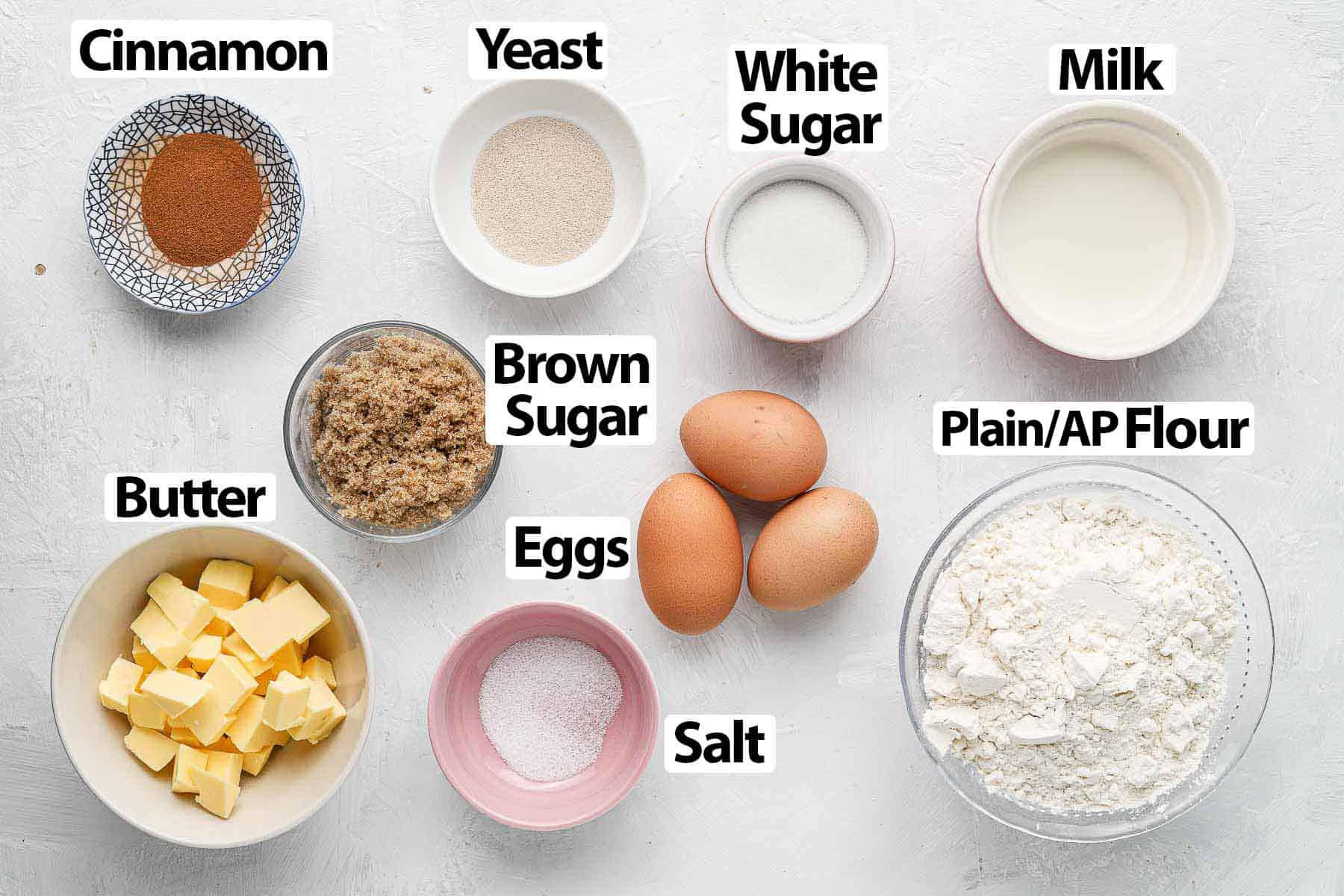
There are three separate elements in this cinnamon babka recipe: the enriched sweet dough that is quite similar to a Brioche, the filling and the sugar syrup that is brushed over the babka after it is baked.
What is cinnamon babka made from (scroll down to recipe card below for all quantities):
Babka Dough
- Milk: I used Full Cream / Whole Milk for a richer texture. Alternatively, you can replace the milk with water but will loose in flavour and soft texture.
- Yeast: this recipe uses Instant (dried) Yeast but you can also use Active Dry Yeast. You just have to make sure it is properly "bloomed" - or re-hydrated in a lukewarm liquid before using it.
- Sugar: Caster Sugar, or fine white granulated sugar. It can be replaced with brown sugar if you want a deeper flavour.
- Plain / AP Flour: you can use bread flour instead, but this will give you a lighter, fluffier dough.
- Salt & Cinnamon: the cinnamon is optional for the dough, but I highly recommend it for a boost of cinnamon flavour! The salt is a fine table salt.
- Eggs: I used medium size eggs. It is really important for them to be at room temperature. I also used an extra egg for the egg wash before baking the babka.
- Butter: unsalted butter that is very soft and at room temperature.
Cinnamon Filling
A simple mix of soft unsalted Butter, Brown Sugar and Ground Cinnamon. Optionally, you could also add different spices, some chocolate chunks/chips or even chopped nuts!
Sugar Syrup (optional)
A sugar syrup is simply made with Water and Caster Sugar (fine white granulated sugar). For more flavour, you could also add vanilla extract or paste to it.
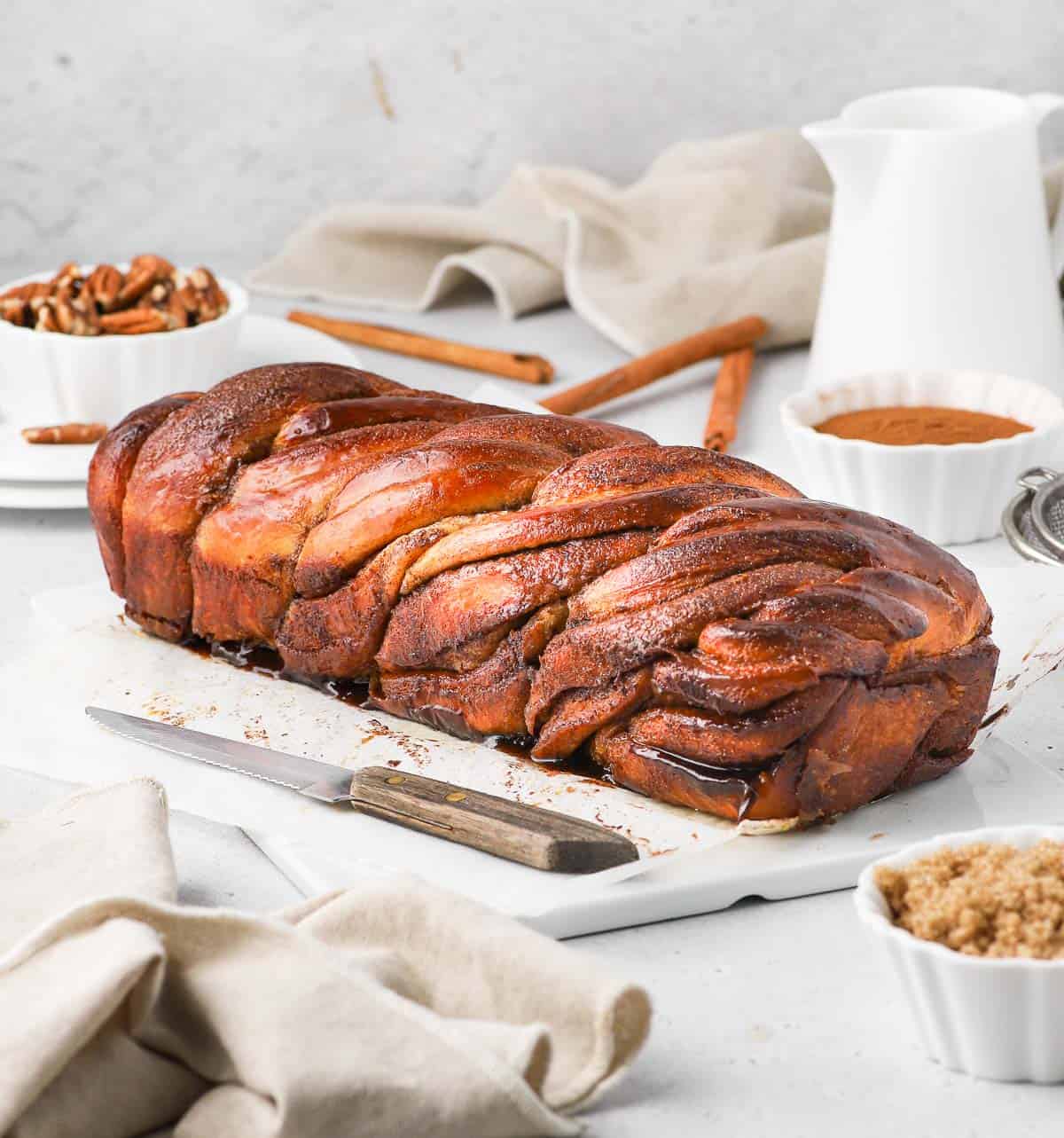
How to make Cinnamon Babka step-by-step
The first step is to prepare the brioche style dough and let it proof. You will then need to roll it, fill it with a cinnamon mixture, twist it to get its original shape and bake it. Optionally, once the cinnamon babka comes out of the oven, you can also brush it with a sugar syrup for a beautiful shine and extra sweetness.
Making the Babka Dough
- Photo 1: Place the warm Milk (it shouldn't be too hot or it will kill the yeast) in the bowl of your stand mixer and mix it with one tablespoon of the sugar. Add the Yeast, stir then let it bloom for about 10 minutes - or until the mixture looks bubbly / frothy.
Note that blooming the yeast is optional here since we are using Instant Yeast, but I like to do it just to make sure the yeast is alive. This step is mandatory if you are using active dried yeast.
- Photo 2: Mix in the Eggs.
- Photo 3: Add the Flour, rest of the Sugar, Ground Cinnamon and lastly the Salt. Fit your stand mixer with the dough hook and knead on medium speed until a sticky dough comes together.
Make sure to add the salt last as you don't want it to be in direct contact with the yeast, which might kill it. I personally like to mix all the ingredients with a spatula first until just combined before using the stand mixer hook attachment.
- Photo 4: Add the soft Butter a little bit at the time, kneading until incorporated before adding more. The dough will be quite greasy at the start so you might need to scrap the edges of the bowl to help the machine.
- Keep kneading on medium high to high speed for about 10 minutes, or until the dough passes the "windowpane test". The babka dough will be very soft and still slightly sticky - that's normal!
- Cover the bowl with a tea towel and leave it to proof in a warm spot for about 1,5 hours, or until it has doubled in size. See FAQs section below if you want to proof it overnight in the fridge instead.
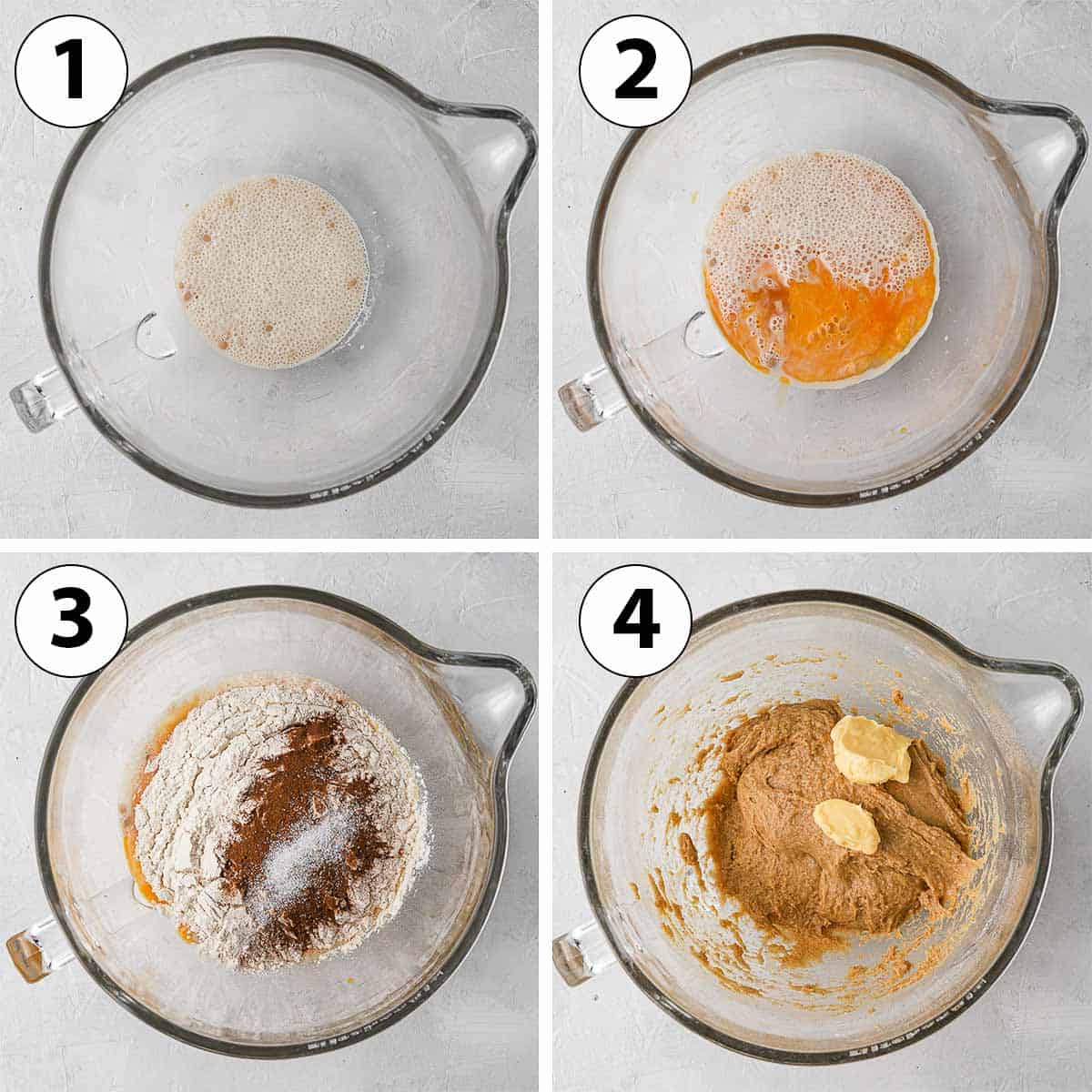
Rolling & Filling
Once the babka dough has finished proofing ("bulk fermentation" stage), it is time to get the filling ready.
- Photo 5: in a small bowl, mix together the soft butter, cinnamon and brown sugar. If the filling seems quite soft or too liquid (happens if the butter was too warm), place it in the fridge for a few minutes until it hardens.
- Photo 6: Punch the cinnamon babka dough to remove the air that has built in and transfer it over a lightly floured surface. Roll the dough into a large rectangle with a rolling pin. I roll the dough to be about 30 x 40 cm (12 x 15 inch rectangle).
- Photo 7: Spread the Cinnamon Filling over the dough using a small offset spatula, silicone spatula or the back of a spoon.
- Photo 8: roll the dough on its longer side to get a log shape, like you would when making cinnamon rolls.
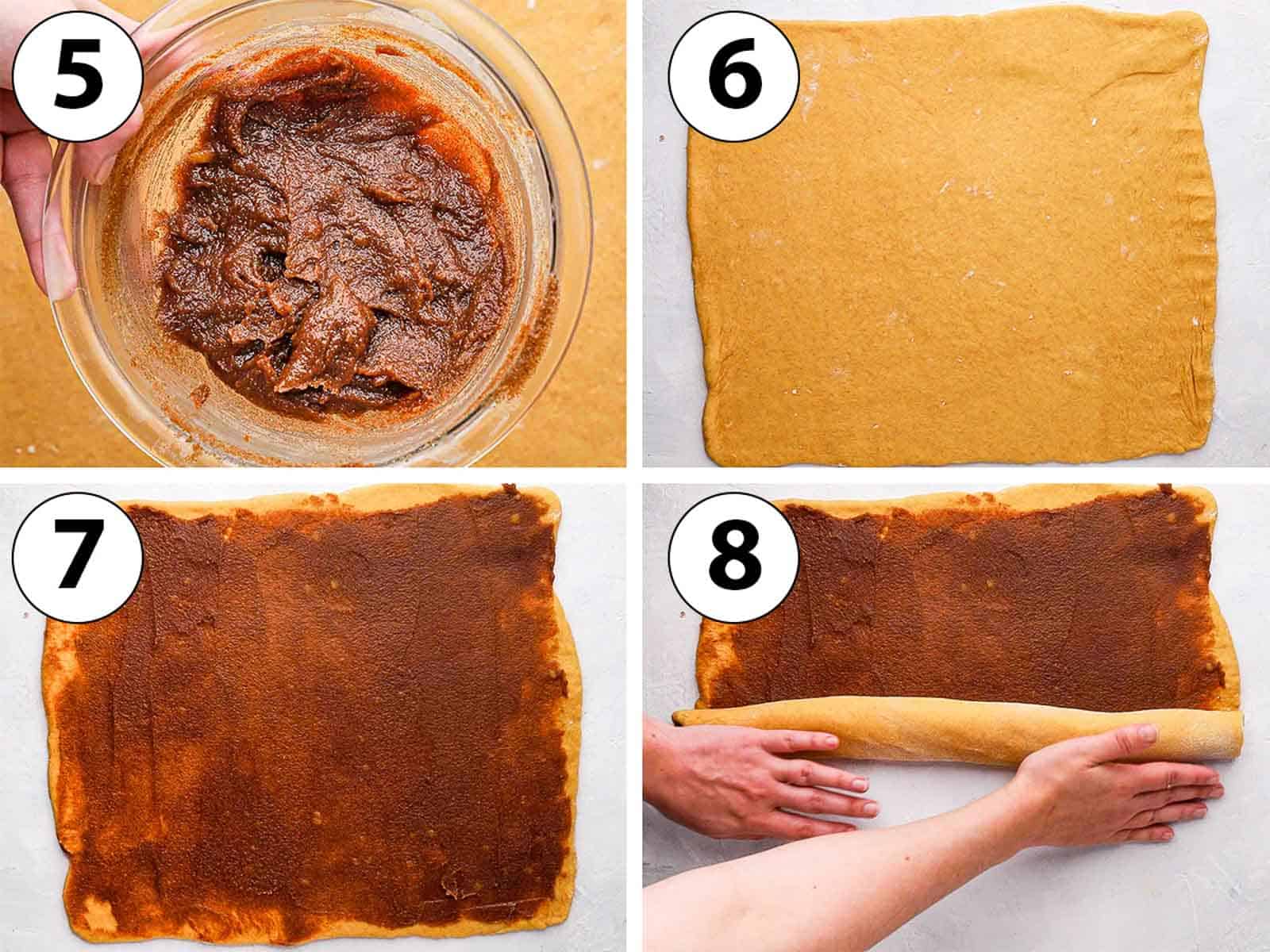
Shaping, Baking and Sugar Syrup
- Photo 9: cut the cinnamon babka dough in half on its length. You should get two pieces of dough and see the layers of cinnamon filling inside.
- Photo 10: twist the two pieces of dough around each other to get the typical babka look. Optionally, cut off the two edges for a cleaner look.
- Photo 11: transfer into a loaf pan that has been greased and lined with baking paper. I used a 11,5x30cm / 4,5x12 inch loaf pan.
- Optional: brush the top of the cinnamon babka with a egg wash (one slightly whisked egg).
- Cover with a tea towel and leave it to proof again in a warm place for 30 to 45 minutes. It should have expanded and risen again.
- Preheat your oven on 180'C/350'F. When the babka has finished the second proofing, place it in the preheated oven for 25 to 30 minutes or until puffed and golden brown.
- While the babka is finishing baking, start preparing the Sugar Syrup. Place the Water and Sugar in a small saucepan and heat up on the stove on medium heat. When the sugar has completely dissolved, remove from the heat.
- Photo 12: Take the babka out of the oven and brush it straight away with the sugar syrup. Once cooled down, you can take it out of the loaf pan and transfer it to a wire rack.
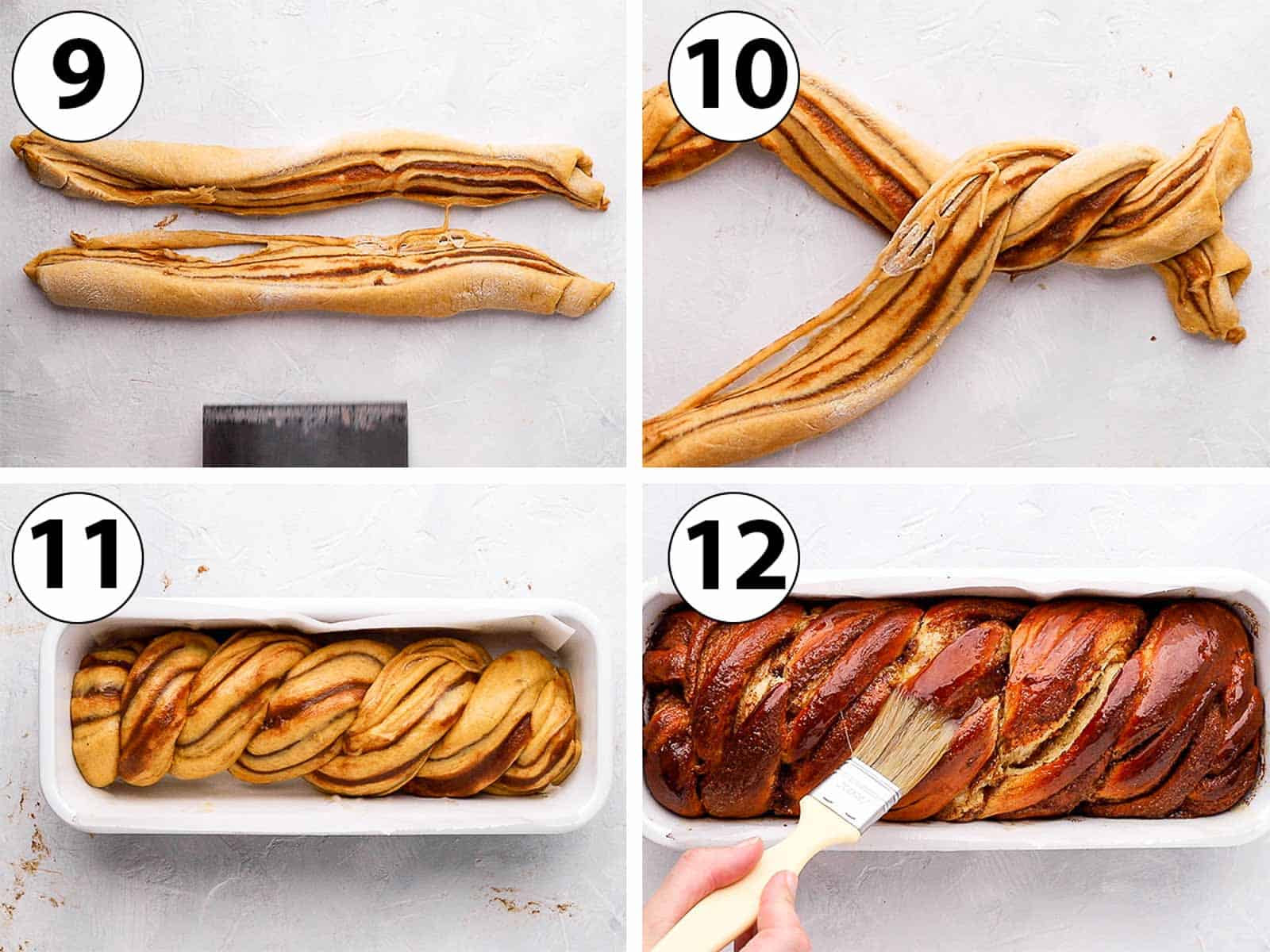
Recipe FAQs
Yes it will work with the same quantities of Bread Flour, but doughs like brioche dough tend to be made with plain/ap flour for a lighter, softer crumb.
Absolutely, this cinnamon babka recipe is great to use as a base and can be easily customised with the addition of your favourite ingredients! You could for example add more Spices (Cardamom, a bit of Nutmeg or Ginger,...), Dried Fruits, chopped nuts like Walnuts or Pecans and even Chocolate Chunks / Chips!
Also yes - you will actually get a deeper flavour and softer texture if you proof the bread overnight in the fridge! To do so, prepare the dough in the evening, properly cover the bowl with plastic wrap and place it in the fridge to proof overnight.
In the morning, take it out of the fridge and let it come back to room temperature for about 30 minutes before rolling it and adding the filling.
You can eat it fresh on its own, slightly re-heated for a few seconds in the microwave or even toasted with butter (truly decadent!). You could also serve it as a dessert more than a bread with a cream cheese frosting for example, or a fruit compote / coulis.
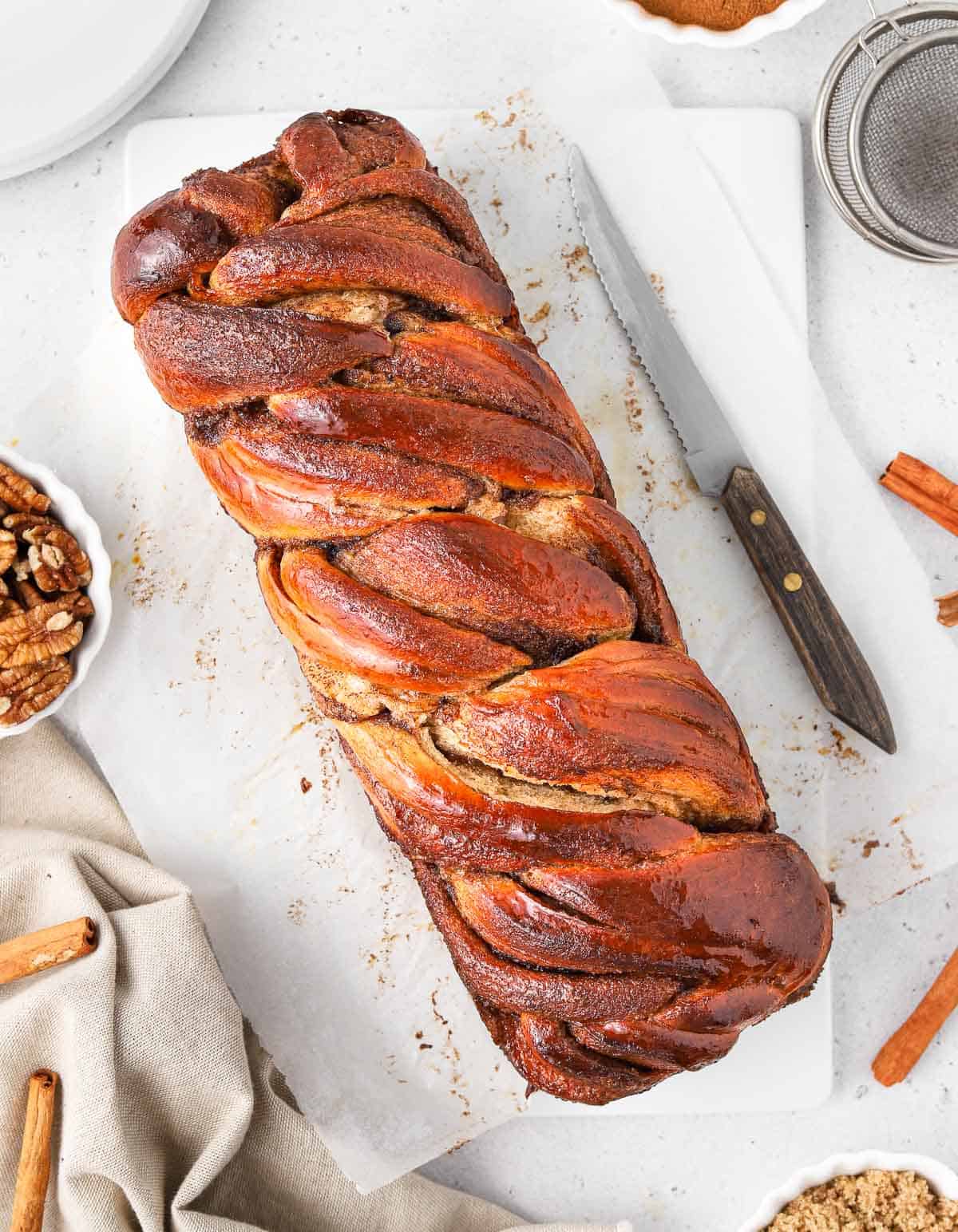
Tips for Success
- Activate the yeast: although not necessary when using instant yeast like here, I recommend "blooming" the yeast (re-hydrating it in a warm liquid) before making the babka to make sure it is alive. Nothing worse than a bread that does not rise because the yeast was not alive!
- Do the "windowpane test" to make sure that you have kneaded the dough for long enough. This is a simple way to check that the gluten has developed enough and the dough is not under-kneaded. To do so, pick up a small piece of dough and slowly stretch it between your fingers. If it breaks, the dough is not ready. If it stretches nicely to a point where you can start seeing light come through the dough, it's ready!
- Proof the cinnamon babka dough overnight in the fridge for deeper flavours and lighter texture. The dough will also be easier to roll and work with when it has been proofed in the fridge.
- Start preparing the Sugar Syrup when the babka has about 10 minutes left in the oven. You want both the cinnamon babka and the sugar syrup to be warm when brushed over to get this beautiful shine and glow!
- Customise the babka filling with the addition of chopped nuts, dried fruits, citrus zest/peels or even chocolate chunks!
Storing & Freezing
This cinnamon babka is better eaten fresh within a day for the best soft and tender crumb. Individual slices can also be re-heated in the microwave for a few seconds to get soft again if the babka has gotten a bit dry.
Babka freeze great - so you can easily prepare it in advance and freeze it until ready! You can freeze it whole (place it on a tray in the freezing until fully frozen then wrap in one layer of plastic wrap and aluminium foil) or in pre-cut slices, separated with baking / parchment paper. Leave to thaw at room temperature when ready.
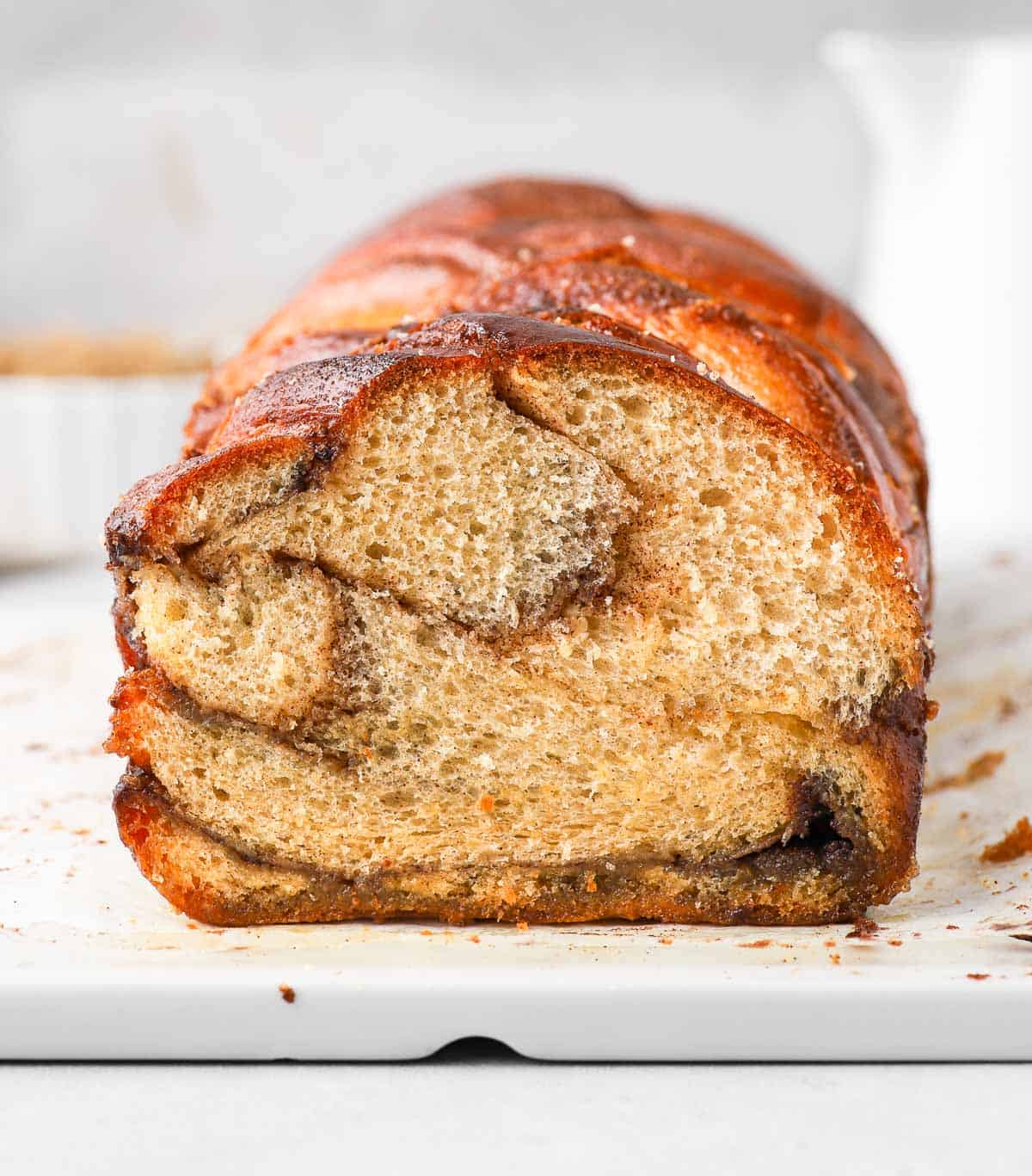
Made this recipe?
Let us know if you liked it by leaving a comment below, and tag us on Instagram @a.baking.journey with a photo of your creation!
Recipe
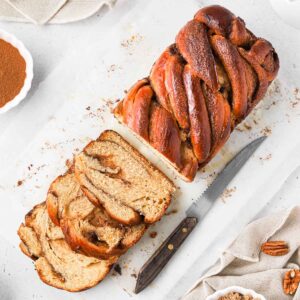
Cinnamon Babka
Ingredients
Babka Dough
- 75 ml (5 tablespoons) Full Cream / Whole Milk
- 60 gr (1/4 cup) Caster Sugar
- 9 gr (2 teaspoons) Instant Yeast
- 3 Eggs - at room temperature
- 350 gr (2 1/3 cups) Plain/AP Flour
- 1 teaspoon Ground Cinnamon
- 1/3 teaspoon Fine Salt
- 90 gr (6 tablespoons) Unsalted Butter - soft
Cinnamon Filling
- 120 gr (1/2 cup) Unsalted Butter - soft
- 100 gr (1/2 cup) Brown Sugar
- 2 teaspoon Ground Cinnamon
- 1 Egg - for the Egg Wash (optional)
Syrup Glaze
- 80 gr (1/3 cup) Caster Sugar
- 80 ml (1/3 cup) Water
Disclaimer
I highly recommend using the measurements in grams & ml (instead of cups & spoons) for more accuracy and better results.
Instructions
Babka Dough
- Place the lukewarm Milk in the bowl of your stand mixer and mix it with one tablespoon of the Caster Sugar. Add the Yeast, stir then let it bloom for about 10 minutes - or until the mixture looks bubbly / frothy.75 ml (5 tablespoons) Full Cream / Whole Milk, 9 gr (2 teaspoons) Instant Yeast
- Add the Eggs then the Plain/AP Flour, rest of the Caster Sugar, Ground Cinnamon and finish with the salt (see note 1). Knead on medium speed with the dough hook until a sticky dough comes together.60 gr (1/4 cup) Caster Sugar, 3 Eggs, 350 gr (2 1/3 cups) Plain/AP Flour, 1 teaspoon Ground Cinnamon, 1/3 teaspoon Fine Salt
- Add the soft Butter a little bit at the time, kneading until incorporated before adding more (see 2). Keep kneading on medium high to high speed for about 10 minutes, or until the dough passes the "windowpane test". The babka dough will be very soft and still slightly sticky - that's normal!90 gr (6 tablespoons) Unsalted Butter
- Cover the bowl with a tea towel and leave it to proof in a warm spot for about 1,5 hours, or until it has doubled in size (see note 3).
Cinnamon Filling
- In a small bowl, mix together the soft butter, cinnamon and brown sugar (see note 4).120 gr (1/2 cup) Unsalted Butter, 100 gr (1/2 cup) Brown Sugar, 2 teaspoon Ground Cinnamon
- Punch the babka dough to remove the air and transfer it over a lightly floured surface. Roll the dough into a large rectangle with a rolling pin, about 30 x 40 cm (12 x 15 inch).
- Spread the Cinnamon Filling over the dough then roll the dough on its longest side to get a log shape. Cut the cinnamon babka dough in half on its length and twist the two pieces of dough around each other.
- Transfer into a loaf pan (11,5x30cm / 4,5x12 inch pan) that has been greased and lined with baking paper. Brush the top of the cinnamon babka with a egg wash then cover with a tea towel and leave to proof in a warm place for 30 to 45 minutes.1 Egg
- Preheat the oven on 180'C/350'F and bake the babka for 25 to 30 minutes or until puffed and golden brown.
Sugar Syrup
- Place the Water and Sugar in a small saucepan and heat up on the stove on medium heat. When the sugar has completely dissolved, remove from the heat.80 gr (1/3 cup) Caster Sugar, 80 ml (1/3 cup) Water
- Take the babka out of the oven and brush it straight away with the hot sugar syrup. Let it cool down completely before removing from the pan.
Tried this recipe? Make sure to leave a comment and star rating below!
Notes
- Plain/AP Flour: can be substituted with bread flour if preferred.
- Yeast: I used Instant Yeast but you can also use Active Dry Yeast - just make sure to properly follow the first step to "bloom" or rehydrate the yeast.
- Make sure to add the salt last as you don't want it to be in direct contact with the yeast, which might kill it. I personally like to mix all the ingredients with a spatula first until just combined before using the stand mixer hook attachment.
- The dough will be quite greasy at the start so you might need to scrap the edges of the bowl to help the machine.
- Alternatively, you could also proof the bread overnight in the fridge. To do so, prepare the dough in the evening, properly cover the bowl with plastic wrap and place it in the fridge to proof overnight. In the morning, take it out of the fridge and let it come back to room temperature before rolling it and adding the filling.
- If the filling seems quite soft or too liquid (happens if the butter was too warm), place it in the fridge for a few minutes until it hardens.

